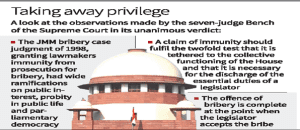LADAKH, ARTICLE 371, AND THE SIXTH SCHEDULE
TAG: GS 2: POLITY
THE CONTEXT: Union Home Minister’s meeting with Ladakh representatives has sparked discussions on extending Article 371-like protections to the region, addressing concerns related to jobs, land, and culture.
EXPLANATION:
- However, the government remains reluctant to include Ladakh in the Sixth Schedule of the Constitution.
Background: Ladakh’s Constitutional Status
- After the repeal of Article 370 in August 2019, Ladakh became a separate Union Territory “without legislature.”
- This separation led to demands from groups like the Leh Apex Body (ABL) and the Kargil Democratic Alliance (KDA) for Ladakh’s inclusion under the Sixth Schedule.
- The Sixth Schedule contains provisions for the administration of tribal areas in states like Assam, Meghalaya, Tripura, and Mizoram.
- It allows the creation of Autonomous District and Regional Councils (ADCs and ARCs) with significant powers, including legislation on forest management, agriculture, administration of villages, inheritance, marriage, and social customs.
Significance of the Sixth Schedule for Ladakh:
- Inclusion under the Sixth Schedule would empower Ladakh to establish elected bodies (ADCs and ARCs) with legislative powers.
- These bodies could address local needs, make laws on various subjects, and resolve disputes within Scheduled Tribes.
- ADCs and ARCs would have authority over land revenue, taxation, regulation of money lending and trading, collection of royalties from mineral extraction, and establishment of public facilities.
Article 371 and Special Provisions:
- Article 371 and subsequent clauses provide “special provisions” for specific states to safeguard the rights and interests of distinct religious and social groups.
- Article 371-A:
- Provides protections for Nagaland, preventing Parliament from enacting laws affecting Nagas’ practices or land ownership without state Assembly concurrence.
- Article 371-G:
- Extends similar safeguards to Mizos from Mizoram.
- Other States and Union Territories:
- Special provisions exist for states like Sikkim (Article 371-F), Arunachal Pradesh (Article 371-H), and Goa (Article 371-I).
- If introduced for Ladakh, it would mark the first instance of special provisions for a Union Territory.
Reservation:
- The government assured the Ladakh delegation that concerns related to jobs, land, and culture would be addressed, stopping short of including Ladakh in the Sixth Schedule.
- The government pledged to ensure representation through hill councils and offered up to 80% reservation in public employment for locals.
- The ongoing discussions about extending Article 371-like protections to Ladakh reflect the complex dynamics of post-Article 370 changes.
- Balancing local autonomy, cultural preservation, and administrative efficiency will be crucial in addressing Ladakh’s concerns while navigating the intricate constitutional landscape.
Sixth schedule:
- Sixth Schedule in the Indian Constitution established Autonomous District Councils (ADC) in four northeastern states, namely Assam, Meghalaya, Tripura and Mizoram.
- The Sixth Schedule was originally intended for the predominantly tribal areas (tribal population over 90%) of undivided Assam, which was categorised as “excluded areas” under the Government of India Act, 1935 and was under the direct control of the Governor.
- The Sixth Schedule of the Constitution provides for the administration of tribal areas in Assam, Meghalaya, Tripura and Mizoram to safeguard the rights of the tribal population in these states.
- The demand for the inclusion of Ladakh in the Sixth Schedule of the Constitution has been a significant topic of discussion and activism in the region.
- The demand for Ladakh’s inclusion in the Sixth Schedule has led to protests, rallies, and calls for shutdowns by various groups advocating for special rights and protections for the people of Ladakh.
